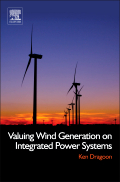Valuing Wind Generation on Integrated Power Systems - Elsevier

Wind powered generation is the fastest growing energy source in the United
States due to a combination of economic incentives, public preference for renewable
energy as expressed in government policies, competitive costs, and the need
to address global warming. The economic consequences of the relative variability
and lower predictability of wind generation are not easily captured in standard
economic analyses performed by utility planners. Valuing
Wind Generation on Integrated Power Systems provides utility analysts and
regulators a guide to analyzing the value of wind generation in the context
of modern power systems.
Guiding the reader through the steps to understanding and valuing wind generation
on modern power systems, Valuing
Wind Generation on Integrated Power Systems approaches the issue from the
various, current perspectives in the US. These include utilities that are still
primarily vertically integrated power providers and systems dominated by independent
system operators (ISOs). Outlined here are the basic procedures in a wind valuation
study, described with enough detail so that analysts spanning a range of resources
and sophistication can reasonably undertake a competent study. Descriptions
of studies performed by other utilities are also provided, explaining their
specific approaches to the fundamentals. Finally, it includes a short section
on power systems that utilize relatively large fractions of wind, and how operating
procedures and valuing techniques may need alteration to accommodate them.
- Reviews operating challenges that large amounts of wind power present to
power systems operators
- Outlines alternative approaches to quantifying the systems services necessary
to accommodate the wind
- Explains how economic analyses of wind generation are competently performed
- Describes how to represent wind generation in computer models commonly
used by electric utility planners that may not be specifically designed to
incorporate wind generation
- Reviews methods used by some select utility companies around the United
States
- Touches on key European issues involving relatively high levels of wind
generation
- Written at the level of the utility planner, assuming a basic understanding
of economic dispatch of generators and elementary statistics
Click here for further information
Terms
While we only use edited and approved content for Azthena
answers, it may on occasions provide incorrect responses.
Please confirm any data provided with the related suppliers or
authors. We do not provide medical advice, if you search for
medical information you must always consult a medical
professional before acting on any information provided.
Your questions, but not your email details will be shared with
OpenAI and retained for 30 days in accordance with their
privacy principles.
Please do not ask questions that use sensitive or confidential
information.
Read the full Terms & Conditions.